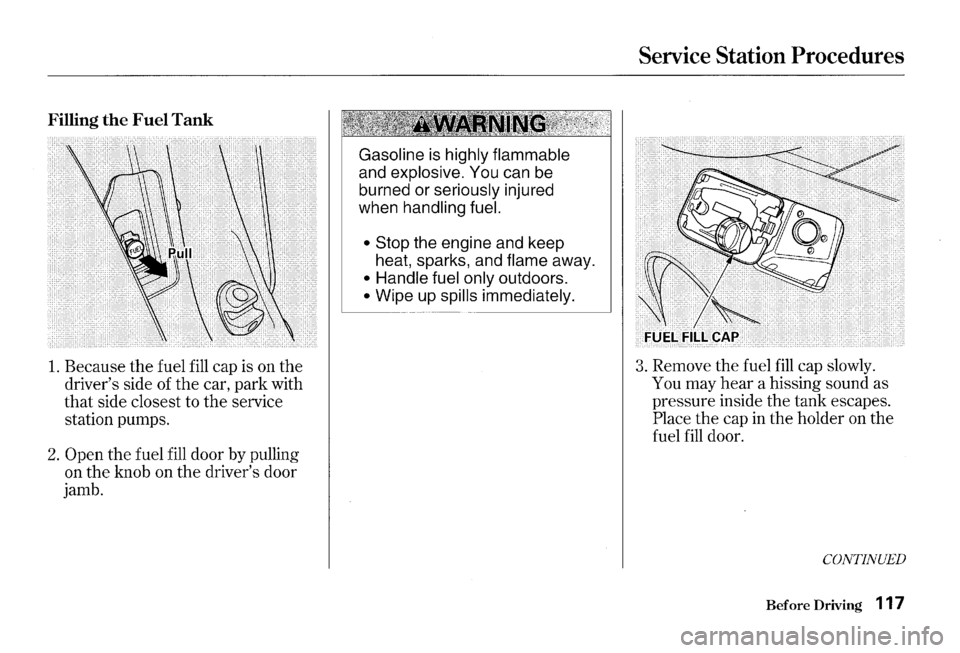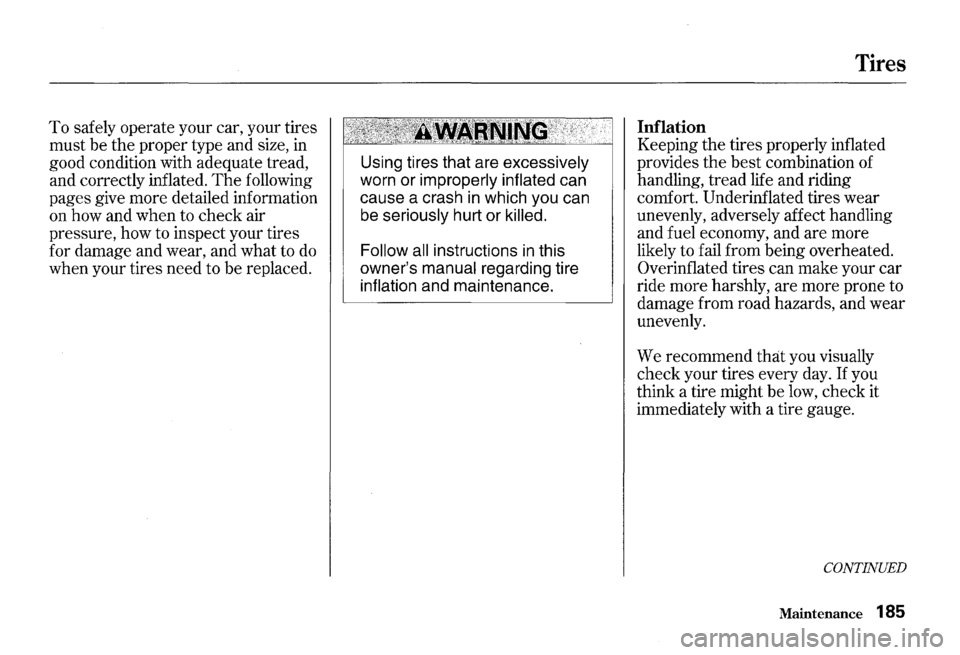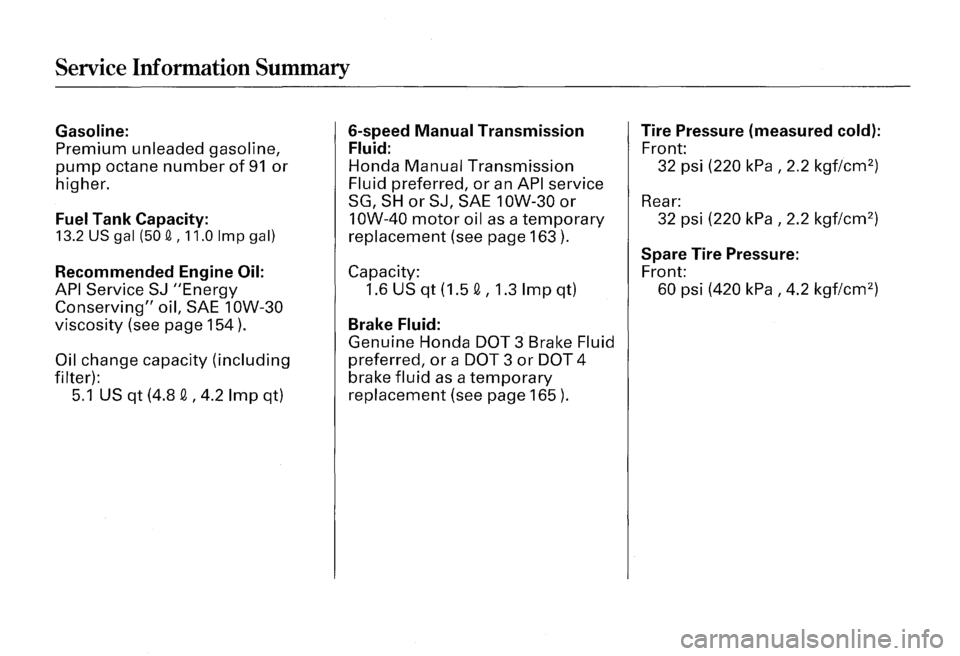2000 HONDA S2000 fuel pressure
[x] Cancel search: fuel pressurePage 120 of 273

1. Because the fuel fill cap is on the
driver's side of the car, park with
that side closest to the service
station pumps.
2. Open the fuel fill door by pulling
on
the knob on the driver's door
jamb.
Gasoline is highly flammable
and explosive. You can be
burned or
seriously injured
when
handling fuel.
• Stop
the engine and keep
heat, sparks, and
flame away.
• Handle fuel only outdoors.
• Wipe up spills immediately.
Service Station Procedures
3. Remove the fuel fill cap slowly.
You may
hear a hissing sound as
pressure inside
the tank escapes.
Place the cap in the holder on the
fuel fill door.
CONTINUED
Before Driving 117
Page 124 of 273

The condition of your car and your
driving habits are the two most
important things
that affect the fuel
mileage you get.
Car Condition
Always maintain your car according
to the maintenance schedule. This
will keep it in top operating condition.
An important part of that mainte
nance is the
Owner Maintenance
Checks
(see page 155 ). For
example, an underinflated tire
causes more
"rolling resistance,"
which uses fuel. It also wears out
faster, so check the tire pressure
at
least monthly.
In winter, the build-up of snow on
your car's underside adds weight and
rolling resistance. Frequent cleaning
helps your fuel mileage and reduces
the chance of corrosion.
Driving Habits
You can improve fuel economy by
driving moderately. Rapid acceler
ation, abrupt cornering, and hard
braking use more fuel.
Always drive
in the highest gear that
allows the engine to run and acceler
ate smoothly.
Depending on traffic conditions, try
to maintain a constant speed. Every
time you slow down and speed up,
your car uses extra fuel.
Use the
cruise control, when appropriate, to
increase fuel economy.
A cold engine uses more fuel than a
warm engine.
It is not necessary to
"warm-up" a cold engine by letting it
idle for a long time. You can drive
away
in about a minute, no matter
how cold it is outside.
The engine
will warm up faster, and you get
better fuel economy. To cut down on
the number of
"cold starts," try to
Fuel Economy
combine several short trips into one.
The air conditioning puts an extra
load on the engine which makes it
use more fuel.
Turn off the A/C to
cut down on air conditioning use.
Use the flow-through ventilation
when the outside air temperature is
moderate.
Before Driving 121
Page 158 of 273

You should check the following
items at the specified intervals.
If
you are unsure of how to perform
any check, turn to the page given.
• Engine oil level -Check every
time you
fill the fuel tank. See
page 119.
• Engine coolant level -Check the
radiator reserve tank every time
you
fill the fuel tank. See page 120 .
• Windshield washer fluid -Check
the level in the reservoir monthly.
If weather conditions cause you to
use the washers frequently, check
the reservoir each time you stop
forfuel. See page 167.
• Brakes and clutch -Check the
fluid level monthly. See page
170 .
Owner Maintenance Checks
• Tires -Check the tire pressure
monthly. Examine the tread for
wear and foreign objects. See page
186.
• Lights -Check the operation of
the headlights, parking lights,
taillights, high-mount brake light,
turn signals, brake lights, and
license plate lights monthly. See
page 192.
Maintenance 155
Page 188 of 273

To safely operate your car, your tires
must be
the proper type and size, in
good condition with adequate tread,
and correctly inflated.
The following
pages give more detailed information
on how and when to check air
pressure, how to inspect your tires
for damage and wear, and what to
do
when your tires need to be replaced.
Using tires that are excessively
worn or improperly inflated can
cause a crash
in which you can
be
seriously hurt or killed.
Follow all
instructions in this
owner's
manual regarding tire
inflation and maintenance.
Tires
Inflation
Keeping the tires properly inflated
provides the
best combination of
handling, tread life and riding
comfort. Underinflated tires wear
unevenly, adversely affect handling
and fuel economy, and are more
likely to fail from being overheated.
Overinflated tires can make your car
ride more harshly, are more prone to
damage from road hazards, and wear
unevenly.
We recommend that you visually
check your tires every day.
If you
think a tire might be
low, check it
immediately with a tire gauge.
CONTINUED
Maintenance 185
Page 266 of 273

Index
D In Bad Weather. ......................... 140 Malfunction Indicator
In Foreign Countries .................
249 Lamp ................................. 45, 228
DANGER, Explanation of.. ............... ii Oil Pressure Indicator ......... 44, 226
Dashboard ........................................
42 E Oil, What Kind to Use ............... 157
Daytime Running Lights ................. 52 Overheating ................................ 223
Dead Battery, What to Do ............ 220 Economy, Fuel ............................... 121 Specifications ............................. 244
Defects, Reporting
Safety ............. 258 Emergencies on the Road ............. 211 Engine Cover, Opening the .......... 118
Defrosting
the Windows ................. 91 Battery, Jump Starting .............. 220 Ethanol in Gasoline ....................... 248
Dimensions ..................................... 244 Changing
a Flat Tire .................
213 Evaporative Emission Controls .... 250
Dimming the Headlights ................ 51 Charging System Indicator ...... 227 Exhaust Fumes ................................ 39
Dipstick Checking the Fuses ................... 232 Expectant Mothers, Use of Seat
Engine Oil.. ................................. 119 Closing the Convertible Top .... 230 Belts by ......................................... 17
Directional Signals ........................... 53 Low Oil Pressure Indicator ...... 226 Exterior,
Cleaning the ................... 204
Disabled, Towing Your Car If ...... 238 Malfunction Indicator Lamp .... 228
Disc Brake
Wear Indicators ......... 136 Overheated Engine ................... 223 F
Disposal of Used Oil.. .................... 160 Emergency Brake ............................ 80
Do Not Tow a Trailer .................... 141 Emergency Flashers ....................... 79 Fabric, Cleaning ............................. 207
Doors Emission
Controls ......................... 250 Fan, Interior ...................................... 86
Locking and Unlocking ............... 62 Engine Features, Comfort and
Monitor Light.. .............................
45 Check Engine Light ............ 45, 228 Convenience
................................. 85
Power Door Locks ....................... 62 Compartment, Checking Filling the Fuel Tank ..................... 117
DOT Tire Quality Grading ........... 246
in the ....................................... 118
Downshifting, 6-speed Manual Coolant ........................................ 120
Transmission .............................. 134 Coolant Temperature Gauge ..... 4 7
Driving ............................................
129 Drive Belt. ................................... 184
Economy ..................................... 121 CONTINUED
Ill
Page 268 of 273

Index
Inspection, Tire .............................. 187 Indicator ........................................ 43 Meters, Gauges ................................ 4 7
Instrument
Panel ............................. 42 Parking ........................................ 198 Methanol in Gasoline .................... 248
Instrument Panel Brightness ......... 52 Turn Signal.. ............................... 196 Mirrors, Adjusting ........................... 79
Interior Cleaning ............................ 207 Loading Cargo ................................ 124
Interior Lights .................................. 83 LOCK (Ignition Key Position) ....... 60 N
Introduction ......................................... i Locks
Anti-theft Steering
Column ........ 60 New Vehicle Break-in ................... 116
J Fuel Fill Door ............................. 117 Normal Shift Speeds ...................... 134
Power Door .................................. 62 NOTICE, Explanation of ................... ii
Jacking Up the Car ........................ 213 Trunk ............................................ 66 Numbers, Identification ................ 242
Jack, Tire ........................................ 213
Low Coolant Level.. ....................... 120
Jump Starting ................................. 220 Lower Gear, Downshifting to a .... 134 0
Low Fuel Indicator .......................... 46
IK Low Oil Pressure Indicator .... 44, 226 Octane Requirement, Gasoline .... 116
Lubricant Specifications
Chart .... 244
Odometer .......................................... 48
Keys ................................................... 58 Luggage .......................................... 124
Odometer, Trip ................................ 48
Oil
L IM Change, How to ......................... 159
Change, When to ....................... 146
Label,
Certification ........................ 242
Maintenance ................................... 143 Checking Engine ....................... 119
Lane Change, Signaling .................. 53 Owner Maintenance Checks .... 155 Pressure Indicator ............... 44, 226
Lap/Shoulder Belts .........................
33 Record ......................................... 153 Selecting Proper Viscosity
Leaking of Exhaust into
Car .......... 39 Schedule ..................................... 146 Chart ....................................... 157
Leather, Cleaning .......................... 207 Malfunction Indicator Lamp .. 45, 228 ON (Ignition Key Position) ............ 61
Lights
Manual Transmission .................... 133
Bulb Replacement ..................... 194 Manual Transmission Fluid ......... 168 CONTINUED
v
Page 273 of 273

Service Information Summary
Gasoline:
Premium unleaded gasoline,
pump octane number of 91 or
higher.
Fuel Tank Capacity:
13.2 US gal (50~, 11.0 Imp gal)
Recommended Engine Oil:
API
Service SJ "Energy
Conserving" oil, SAE 1 OW-30
viscosity (see page 154 ).
Oil change capacity (including
filter):
5.1 US qt (4.8 fJ , 4.2 Imp qt) 6-speed
Manual Transmission
Fluid:
Honda Manual Transmission
Fluid preferred, or an API service
SG,
SH or SJ, SAE 1 OW-30 or
10W-40 motor oil as a temporary
replacement (see page 163 ).
Capacity:
1.6 US qt (1.5 Q, 1.3 Imp qt)
Brake
Fluid:
Genuine Honda DOT 3 Brake Fluid
preferred, or a DOT 3 or DOT 4
brake
fluid as a temporary
replacement (see page 165 ).
Tire Pressure (measured cold):
Front:
32 psi (220 kPa , 2.2 kgf/cm2
)
Rear:
32 psi (220 kPa , 2.2 kgf/cm2
)
Spare Tire Pressure:
Front:
60 psi (420 kPa , 4.2 kgf/cm2
)